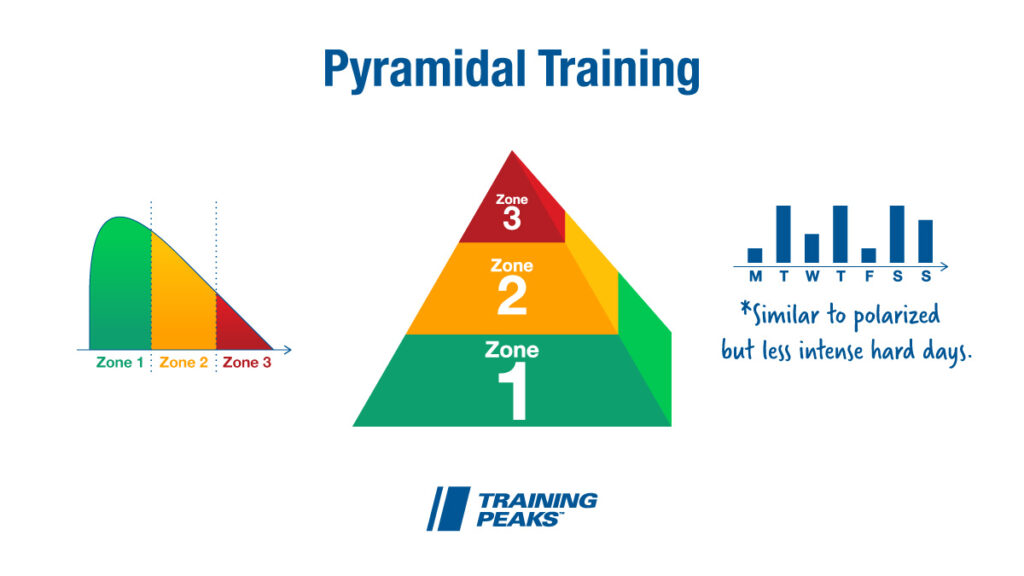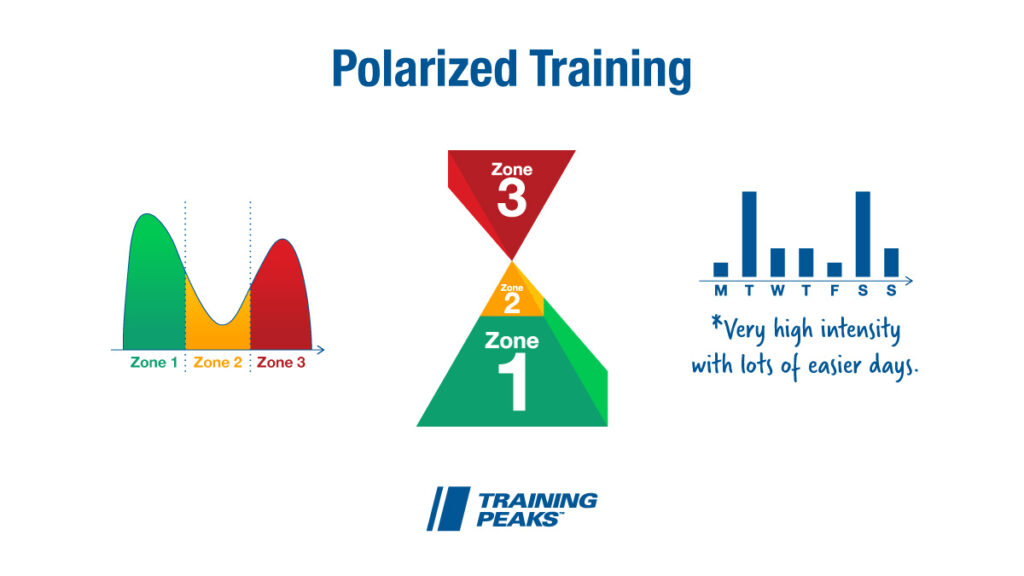There’s no doubt that a periodized approach to endurance training delivers consistent results. But are there certain types of periodization that are more effective than others? Over the past few years, there’s been an ongoing debate about whether polarized or pyramidal training delivers a line of best fit for most athletes. Let’s look at both methods and see which you might want to implement with your clients.
First, it’s essential to set the scene. It’s probably fair to assume that each of your athletes has a finite amount of bandwidth in their schedule to dedicate to running, cycling, swimming or cross-training, even if they’re a pro or competitive amateur. This calendar crunch is more acute for busy professionals and parents, so how they spend this time is important. Training Intensity Distribution (TID) attempts to quantify how long they spend training at specific intensities or in certain zones.
The latter can be broken down into as many as five distinct segments, but for the sake of simplicity, let’s go with a three-zone model. Zone one is the typical bread and butter of endurance athletes. It’s the lowest intensity and is sometimes referred to as LSD — no, not the drug, but rather long, slow distance. Heart rate should stay at or under 70 to 75% of your max. Zone two is medium intensity, often performed over middle distance with heart rate at 75 to 85%. And Zone three is higher intensity work over shorter distances, such as interval training or hill sprints — performed at 85% or above.
All three zones can be measured by subjective intensity, such as the rate of perceived exertion (RPE) that one of your athletes assigns to each of the training sessions you prescribe or the paces you recommend. This feature can also be measured objectively using a heart rate monitor or wearable. Now let’s look at how TID, zones, and other factors apply to pyramidal and polarized training models.

Building from the Bottom Up with Pyramidal Training
As its name suggests, pyramidal training can be viewed like a triangle with three distinct layers. On the bottom, the foundational layer is what we’d typically call the aerobic base – plenty of miles accumulated doing LSD work in zone one. This is where your athletes will spend the majority of their time.
Moving up to the middle of this pyramid, a moderate amount of training is done in zone two, with moderate intensities spread out over intermediate distances. This is often referred to as threshold training, whereby athletes sustain their heart rate just below their aerobic threshold (around 60 to 70% of max heart rate). Going up to the top of the pyramidal triangle, the least time is devoted to short, high-intensity efforts performed in zone three.
One of the advantages of pyramidal training is its simplicity and logical progression. It is easy for you as a coach and your training group to grasp and implement: spend a lot of time going long and slow, some time at a moderate pace and a bit of time moving hard and fast. There’s little ambiguity and the TID is a linear progression up through the three zones.
This makes programming simpler and encourages adherence, not least because most athletes buy into the traditional approach to endurance work that pyramidal training adheres to. On the flip side, critics say that it requires a more significant total commitment to building that aerobic base and that pyramidal training neglects developing the speed and power needed for shorter races, catching breakaways, and finishing fast in competition.
There’s also the suggestion that too many “junk miles” aren’t developing aerobic or anaerobic capacities.

Getting Rid of the Middle with Polarized Training
Like the pyramidal method, polarized training – popularized by the work of exercise physiologist Dr. Stephen Seiler – can also be viewed through the lens of the three main training zones and a TID perspective. The most significant similarity between the two approaches is that they both emphasize your athletes are spending most of their time in zone one. So far, so good. But it’s in the next two zones that there’s a flip-flop.
If they’re using polarized, your clients will spend very little time in mid-paced zone two sessions and a moderate amount on higher-intensity efforts in zone three. In his bestselling book “80/20 Running: Run Stronger and Race Faster By Training Slower,” Matt Fitzgerald summarizes this as an 80/20 TID split between the upper and lower zones that helps runners “break out of the moderate-intensity rut.”[i] Note that his model has five zones with different names and a more nuanced approach than the three-zone model.[ii]
As my fellow TrainingPeaks contributor, Philip Mosley, wrote, spending most time training comparatively slowly “lays an impressive aerobic foundation.” While devoting 20% of training at a higher intensity will “raise your lactate system with some input from your most immediate energy system, the ATP-PC system (adenosine triphosphate and phosphocreatine system), which provides energy for all-out 10-15-second efforts like a finish-line sprint.”[iii]
It’s one of the core arguments for proponents of polarized training that it will give you everything you need to support the demands of racing without the miles in the medium intensity band that aren’t hard or easy enough to develop the energy systems responsible for sustained efforts or fast bursts of speed.

What Do the Studies Say?
Pyramidal training has a more extensive evidence base to back it because it has been a staple approach for so long and is the subject of years of experiments. Recently, more researchers have investigated the efficacy of the polarized method, and some have pitted it against other types of programming, including pyramidal.
It’s worth noting that people who are starting from scratch or have a low training age will respond to just about any kind of plan, while the more advanced an athlete is, the less likely they are to see huge adaptations or gains, which is why some of the studies need to be taken with a grain of salt.
If you are trying to decide whether a polarized or pyramidal plan is more suitable for your clients, it might be frustrating to find that one piece of literature contradicts the next. Let’s look at studies that find in favor of polarized training first. Sports scientists from the University of Lille in France concluded that top-class marathon runners spend more time training at higher velocities and accumulating more mileage, suggesting a polarized approach.[iv]
A Frontiers in Physiology paper compared high-volume, high-intensity interval, threshold and polarized training and discovered that the latter “resulted in the greatest improvements in most key variables of endurance performance in well-trained endurance athletes.”[v] These included increases in VO2 max, time to exhaustion, and peak velocity and power.
These findings support the claim of polarization advocates that the method builds baseline endurance and top-end speed simultaneously. Polarized training has also been shown to benefit athletes with less training experience. Seiler and several colleagues compared it to three other training methods for 10 weeks, after which they wrote: “Polarized training can stimulate greater training effects than between-thresholds training in recreational runners.”[vi]
But then there are the studies that have found little difference between polarized and pyramidal programming. A group of Austrian and German researchers compared two groups of elite rowers and found that neither proved superior to the other in terms of performance outcomes.[vii] They speculated that this could’ve been because all the athletes did equal work in zone one. Their overall volume was also about the same, suggesting a second reason for similar results.
Another study conducted at the University of Alicante in Spain found that triathletes who prepared for a half-Ironman race finished an average of just two seconds apart after following pyramidal and polarized programs. The authors contended that “coaches should not rule out the training prescription in zone 2, since the training time in this zone positively correlated with the performance in the Half-Ironman competition.”[viii] They also mentioned that zone two work improved performance in the running portion of the race.

Pyramidal, Polarized or Both?
So, in the end, I bet you have a single question after reading this seemingly contradictory research, “Is pyramidal or polarized training better for my clients?” As annoying as it may be, I’m going to quote my “Unplugged” co-author Dr. Andy Galpin, a muscle physiologist at Cal State Fullerton: “It depends.”
As some research shows, polarized training can deliver a lot of bang for your athletes’ time investment buck. It seems to promote adaptations for less experienced people, so it might be more suited to those recreational athletes. They only have a few hours a week to devote to training. More advanced athletes with a solid aerobic base might benefit too.
On the other hand, pyramidal training has been utilized for so long because it’s effective too. As Tasmania-based Carson McQuarrie from Thomas Endurance Coaching wrote, “What studies have shown is when time is measured, virtually all well-trained and elite endurance athletes, across different sports, follow a Pyramidal model of TID.”[ix] So for your more competitive clients, a pyramidal approach is probably acceptable.
This doesn’t have to be an either/or fork-in-the-road decision. As veteran strength coach Dan John wrote, “I think everything works for about six weeks.”[x] In other words, you can always transition your clients from pyramidal to polarized training, back again and then to another approach. Let them adapt for the duration of a whole training block and then switch up the stimulus to avoid stagnation and help them develop a wide range of physical qualities and all their energy systems at different times of the year. Measure, experiment and repeat.
This is supported by a study published in the “Scandinavian Journal of Medicine & Science in Sports,” which compared well-trained runners doing 16 weeks of polarized or pyramidal training or two eight-week blocks starting with one and ending with the other. After reviewing the results of the four groups, the authors concluded, “Each intervention effectively improved endurance surrogates and performance in well-trained endurance runners. However, the change from pyramidal to polarized distribution maximized performance improvements.”[xi]
You could also deploy either approach situationally. So if a client complains that they missed the podium in a race because they got smoked during the mad sprint to the finish, perhaps a polarized approach with a bit more time spent in zone three would be beneficial. Or if they post a couple of DNFs in longer events, then perhaps their baseline endurance and moderate intensity output are lacking, and they’d do well to go back to the zone one, two, and three spread of pyramidal training.
It’s too easy to say this or that training program is good or bad, better or worse. Look at the situation, see where the client is, where they’ve been, and what they want to achieve, and then utilize pyramidal and polarized approaches as two more tools in your coaching toolbox.
References
[i] Matt Fitzgerald, 80/20 Running: Run Stronger and Race Faster By Training Slower, (New York: Berkley Books, 2014), 19.
[ii] Matt Fitzgerald, “Understanding Your 80/20 Endurance Run Plan,” 80/20 Endurance, available online at https://www.8020endurance.com/understanding-your-8020-run-plan.
[iii] Philip Mosley, “Does Polarized Training Really Work?” TrainingPeaks, available online at https://www.trainingpeaks.com/blog/does-polarized-training-really-work.
[iv] VL Billat et al, “Physical and Training Characteristics of Top-Class Marathon Runners,” Medicine and Science in Sports and Exercise, December 2001, available online at https://pubmed.ncbi.nlm.nih.gov/11740304.
[v] Thomas Stöggl and Billy Sperlich, “Polarized Training has Greater Impact on Key Endurance Variables than Threshold, High Intensity, or High Volume Training,” Frontiers in Physiology, 2014, available online at https://www.ncbi.nlm.nih.gov/pmc/articles/PMC3912323.
[vi] Iker Muñoz et al, “Does Polarized Training Improve Performance in Recreational Runners?” International Journal of Sports Physiology and Performance, March 2014, available online at https://pubmed.ncbi.nlm.nih.gov/23752040.
[vii] Gunnar Treff et al, “Eleven-Week Preparation Involving Polarized Intensity Distribution Is Not Superior to Pyramidal Distribution in National Elite Rowers,” Frontiers in Physiology, August 2017, available online at https://pubmed.ncbi.nlm.nih.gov/28824440.
[viii] SS Perez et al, “Polarized and Pyramidal Training Intensity Distribution: Relationship with a Half-Ironman Distance Triathlon Competition,” December 2019, Journal of Sports Science & Medicine, December 2019, available online at https://www.ncbi.nlm.nih.gov/pmc/articles/PMC6873141.
[ix] Carson McQuarrie, “Periodized Training Models: Pyramidal? Polarized? Both? Neither?” Thomas Endurance Coaching, available online at https://www.thomasendurancecoaching.com/pyramidal-polarized-both-or-neither/
[x] Dan John, “My Fat Loss Clients and ‘Everything Works,’” Danjohn.net, September 2011, available online at https://danjohn.net/2011/09/my-fat-loss-clients-and-everything-works.
[xi] Luca Filipas et al, “Effects of 16 weeks of Pyramidal and Polarized Training Intensity Distributions in Well-Trained Endurance Runners,” Scandinavian Journal of Medicine & Science in Sports, available online at https://pubmed.ncbi.nlm.nih.gov/34792817.









